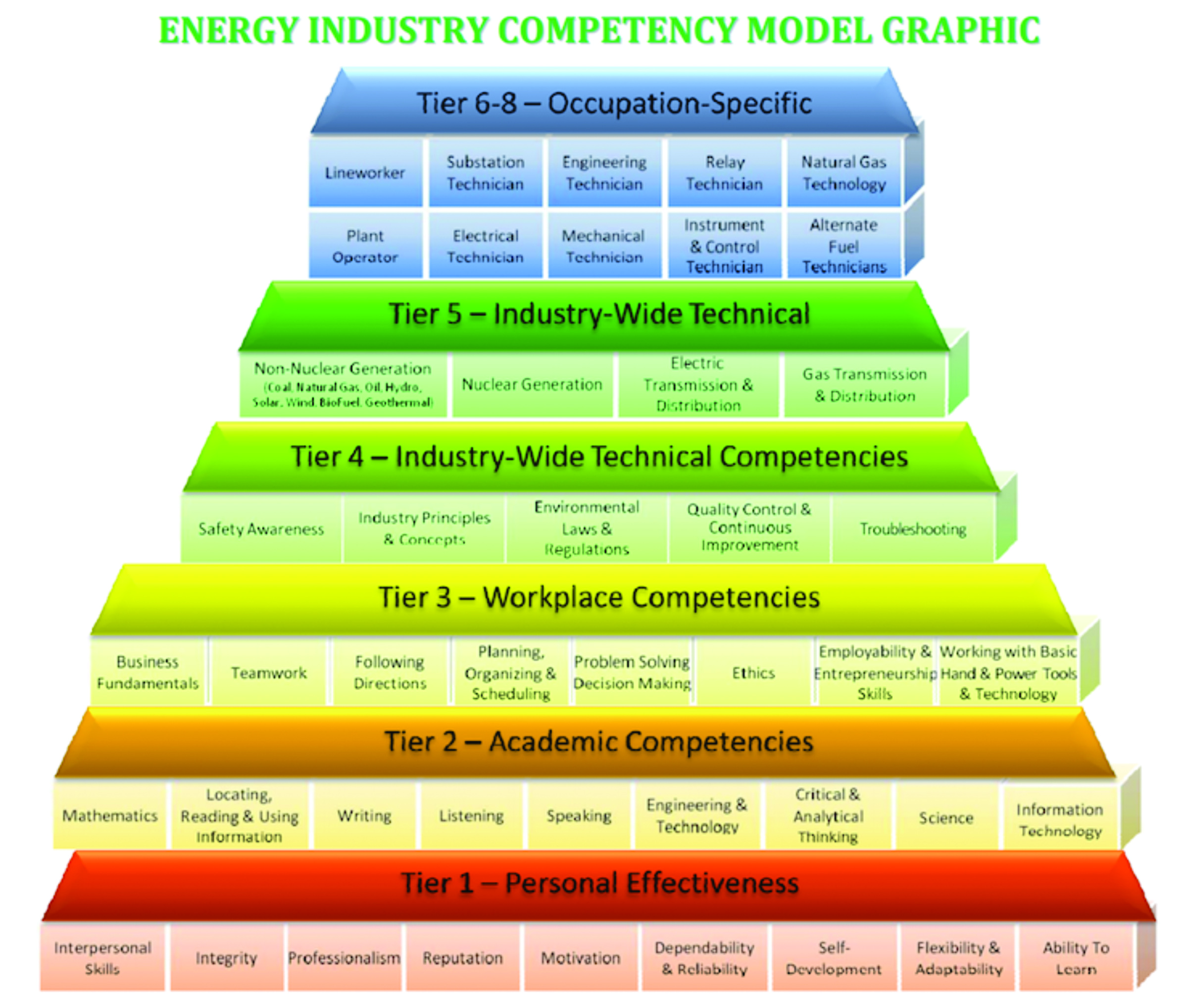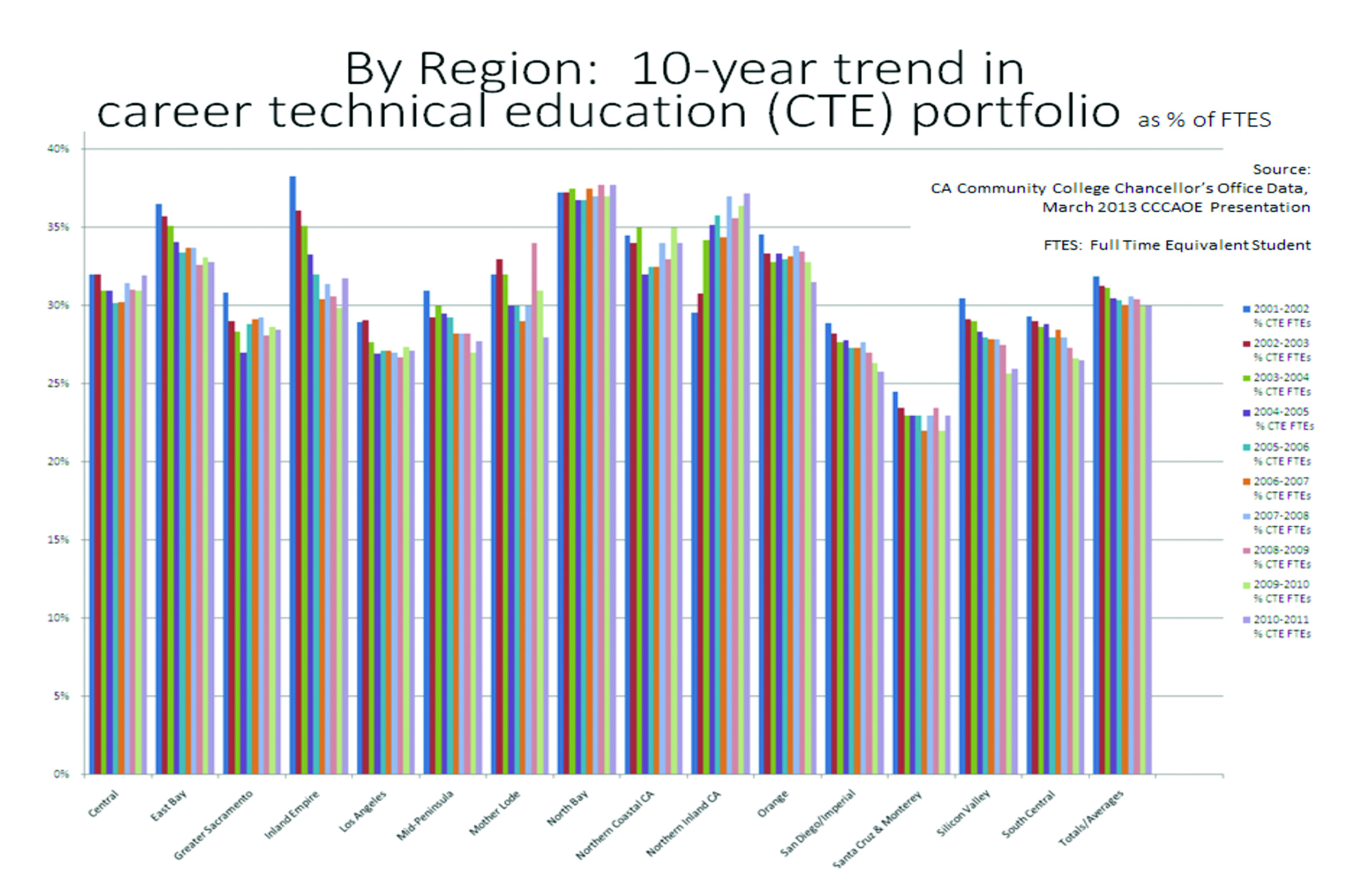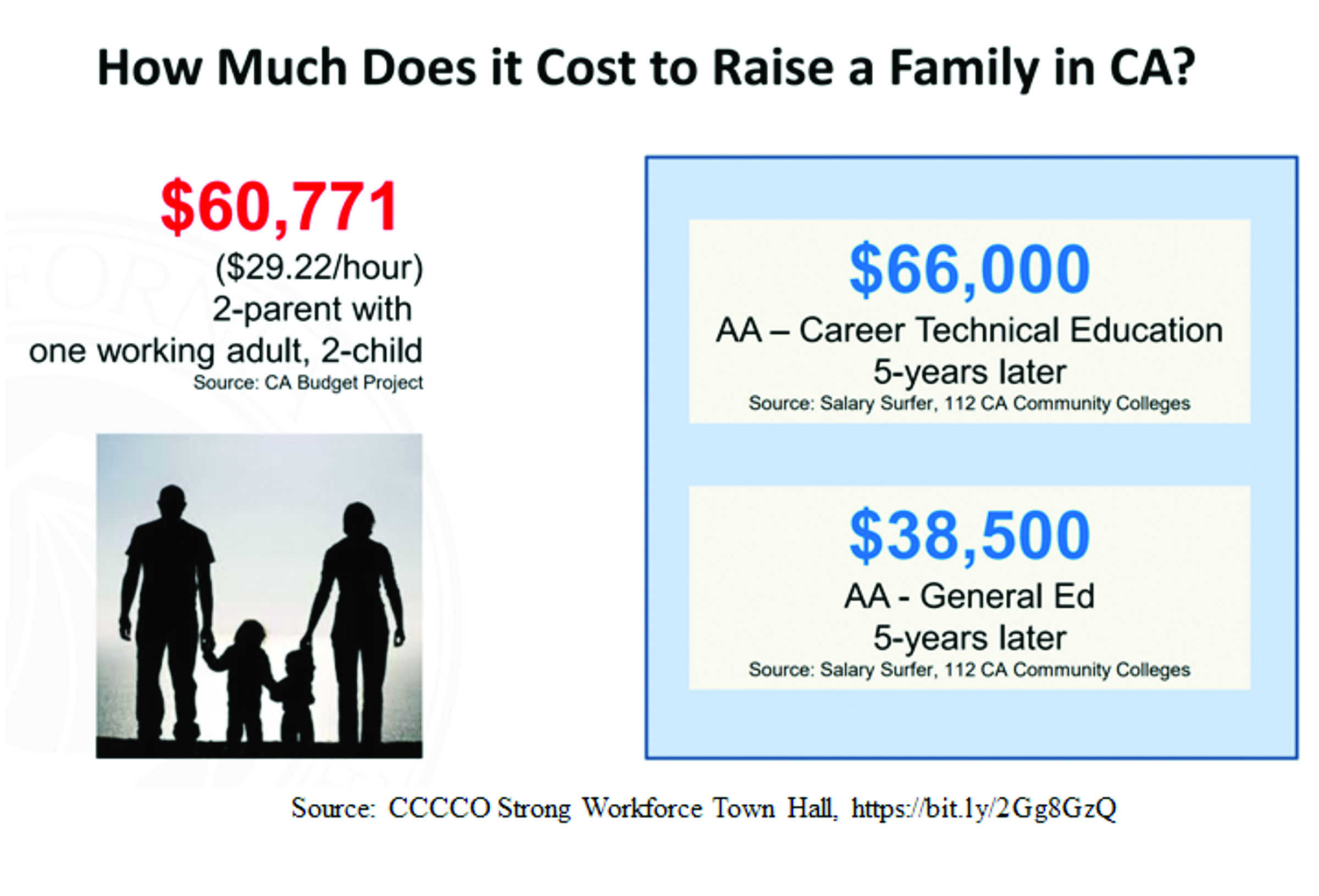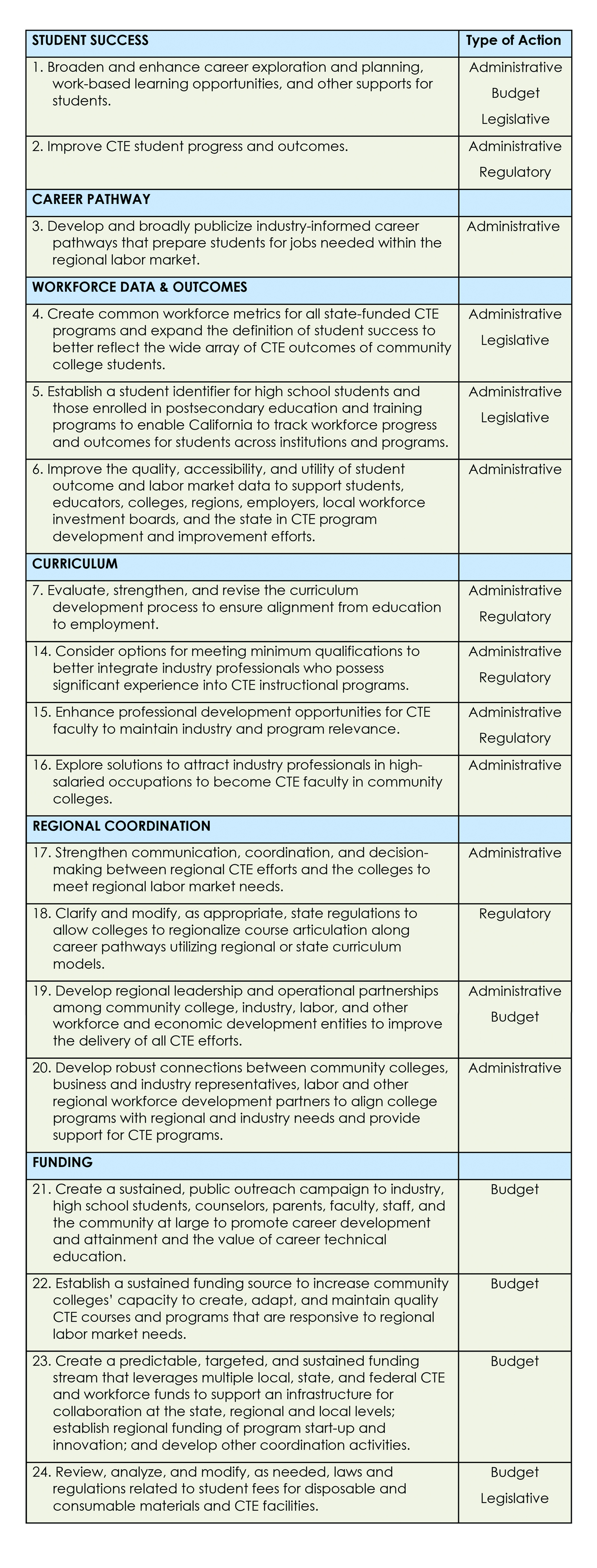- Energy & Environment
Introduction1
Since 2012, the California Community Colleges (CCC) system has been driving transformation of its workforce mission to better address labor market needs. From 2012–2018, the California Community Colleges Chancellor’s Office (CCCCO) deepened its commitment to modernizing the system’s career and technical education (CTE) programs and infrastructure. The approach taken by the CCCCO was informed by two public policy principles surfaced through the convenings of the California Economic Summit: 1) approach the State as a set of regional economies rather than a monolithic one, and 2) expand CTE capacity in order to provide skilled workers needed by regional economies.2 The efforts ushered in an era of experimentation, innovation, and collaboration by California’s community colleges and their ecosystem of partners to deliver more workforce programs with better student outcomes.
This renaissance pervaded the state and drove conversations about workforce development from an afterthought to a statewide policy priority. The purpose of this paper is to set the context for and explore this renaissance. The paper is divided into three parts. Part I provides an overview of the nation’s shift from a manufacturing- to a knowledge-based economy; presents current demographic data about postsecondary students; reviews research on pathways to good jobs; and outlines program elements necessary for building CTE capacity at community colleges. Part II provides a provides a case study of the CCCCO’s efforts to reimagine and modernize workforce programs across its colleges. Finally, Part III offers higher education six lessons to meet the nation’s workforce needs—as informed by the experience of the California Community Colleges.
Part I: The Knowledge-Based Economy
Over the last 50 years, the United States has shifted from an industrial- to a knowledge-based economy. Technological innovations and globalization, among other factors, have profoundly affected the pathway to economic opportunity. With each passing year, there are fewer good jobs capable of supporting a family for those with a high school education and more jobs that require at least some postsecondary education and training. As a result, workers must increase their skills and credential attainment, or “upskill,” to participate in the job market. “Whereas two out of three entry-level jobs in the industrial economy demanded a high school diploma or less, now two out of three jobs demand at least some education or training beyond high school.”3
As jobs have changed, so have the needs of employers. Employers seek “graduates with a broad array of knowledge and skill—not just specific content knowledge, but transferable skills like critical thinking, the ability to solve unscripted problems, and to communicate effectively.”4 Despite high need and good salaries, employers often cannot find enough educated and/or skilled workers. As of January 2019,5 the number of open jobs in the United States hovered at 7.6 million, up from 4 million in 2014.6 An examination of the nation’s postsecondary attainment, confirms employers’ struggles. Today, the United States ranks 13th in global postsecondary attainment behind Canada, Japan, South Korea, the Russian Federation, and the United Kingdom. In 2017, the average postsecondary degree attainment in the United States was 48 percent of 25-34-year-olds. In contrast, South Korea’s average degree attainment for 25-34-year-olds was nearly 70 percent.7
In response to these changes, the Obama Administration8 and the philanthropic community began a campaign with a national goal to increase the number of Americans with a high-quality degree, certificate, or other credential from an historical rate of 39 percent to 60 percent of Americans by 2025.9 The intensified focus on postsecondary attainment appears to be working. Nationally, “the share of 25-34-year-olds with a tertiary (postsecondary) degree has increased by 7 percentage points since 2007, reaching 48 percent in 2017.”10 Between 2019 and 2025, the Lumina Foundation estimates that approximately 24.2 million Americans will earn postsecondary credentials, given current rates of attainment. Though this number is substantial, it falls short of the 60 percent goal. To achieve that goal requires an additional 16.4 million earned degrees or credentials.11
Today’s Postsecondary Student
Postsecondary education in the United States has undergone dramatic changes. Women, who attended institutions of higher education in low numbers well after WWII, now comprise almost 60 percent of undergraduates.12 No longer are college students predominantly recent high school graduates ages 18 to 21. Students today are a diverse group managing multiple commitments and challenges. Data collected by the Lumina Foundation illustrates this point. Of today’s college students:
- 37 percent are 25 or older
- 46 percent are first generation
- 42 percent are people of color
- 64 percent work, and 40 percent of these work full time
- 49 percent are financially independent from their parents
- 24 percent have children or other dependents
- 31 percent come from families at or below the Federal Poverty Guideline.13
In addition to these demographic changes, there has been a shift in the primary reasons motivating students to pursue higher education. In the 1980s, students reported that they sought to learn more about themselves and their potential first and the ability to gain employment as a result of their degree second. Sensitive to the rapidly changing job market, now students’ primary focus is on identifying a clear degree or credential path that will lead to a job.14 Students are also aware of how expensive postsecondary education and training can be, and the likelihood that they will have to borrow to complete their educational goals. Students have good reason to be concerned. “Tuition has increased 503 percent more than inflation over the last 35 years.”15 For students, there is a real need for a return on their educational investment so they can support themselves, provide for their families, pay their loans, and save for their retirements. Students need good jobs.
Pathways to Good Jobs
In Three Educational Pathways to Good Jobs, three pathways to jobs capable of supporting a family are identified, including: high school, middle skills (often earned through community colleges), or bachelor’s degree. The report emphasizes the key role community colleges play in helping students prepare for good jobs.16 While much of the opportunity has been for students earning bachelor’s degrees, a significant area of growth has been in the middle skills pathway for students completing associate’s degrees, certificates, certifications, licenses, and some college but no degree. Middle skills jobs account for 24 percent of good jobs and “good jobs are growing the fastest among workers with associate’s degrees (AAs).”17 Between 1991 and 2016, the middle skills pathway added 3.5 million jobs while the high school pathway lost 1.8 million.18 The middle skills pathway benefited from a surge of skilled-service jobs that include healthcare, education, business, finance, and leisure and hospitality.19 “The growth of good middle-skills jobs in skilled-services industries has proved a wellspring of opportunity.”20
In response to these factors, President Obama held the first summit of community college leaders in 2010. In his remarks, the President noted, “[i]n the coming years, jobs requiring at least an associate’s degree are going to grow twice as fast as jobs that don’t require college. We will not fill those jobs—or keep those jobs on our shores—without community colleges.”21
Building CTE Capacity at Community Colleges
Building on the Summit, the Obama Administration sought to modernize the nation’s public workforce system. In 2014, the Workforce Innovation & Opportunity Act (WIOA), previously the Workforce Investment Act, was signed into law.22 Simultaneously, the White House and the National Economic Council in partnership with the Departments of Commerce, Education and Labor developed an action plan to implement a job-driven and employer-led system of workforce development “connected to real jobs in local or regional labor markets, and resulting in skills and credentials that help individuals succeed in the labor market.”23
As the pathway to economic opportunity continues to shift from a manufacturing- to a knowledge-based economy and beyond,24 higher education will be asked to respond to rapid changes in job creation with corresponding education and training, community colleges are an important partner in the alignment of degree attainment and workforce needs. Every year community colleges enroll approximately 13 million students in credit and non-credit courses.25 Community colleges are open admission, close to home, and affordable. In addition to traditional general education pathways, community colleges offer a variety of career technical education (CTE) programs. CTE programs provide training for a variety of careers including but not limited to nurses, emergency medical technicians, welders, utility lineworkers, plant operators, maintenance and repair technicians, and early childhood education providers.
Building CTE capacity and availability at community colleges institutions requires many program elements to be successful, including:
- Understand labor market needs. Responding nimbly to changing workforce demands requires policymakers, administrators, and faculty understand labor market needs and trends at all levels—local, regional, and state—and allocate resources in accordance with an understanding for those needs.
- Engage employers. Traditionally, developing new programs has been the domain of faculty. Designing relevant career technical education programs requires that faculty authentically engage employers in curricular design and implementation—to ensure that the skills students developed are current.
- Respond to the life cycle of new jobs. For many of the new jobs emerging in the workplace, the traditional life cycle of developing CTE curriculum for a new program is too long. In five years, for example, jobs can fundamentally change or disappear. As a result, the timeline to develop and implement a new program needs to be timely to match the lifecycle of workforce demands.
- Modularize education and training programs. Modularizing curriculum offers one way to close the gap between the skills students have and the skills employers need. Modules can augment existing CTE programs to allow for a more rapid response to changing workforce needs. In addition, shortened curricular pathways can be more palatable for working adults who may need only a skill booster rather than a degree to be attractive in the job market. Creating curricular components that can be mixed and matched allows customization for geographical differences in industry needs.
- Pool employer demand. For a new program to be viable, colleges need to enroll a minimum cohort of 15-25 students. Hence, colleges produce graduates in volume. In contrast, employers tend to hire a limited number of people trained for the same occupation at any one time, leaving most of the cohort without employment. To match supply of graduates with demand of hires, two options are available: 1) an employer must aggregate job postings, or 2) multiple employers must pool their hiring to time with the graduation.
- Braid resources. As discussed, students are a diverse group with wide-ranging needs. For many students, financial aid for tuition does not meet their full cost of attending postsecondary education and training. For example, students may need assistance with child or other dependent care, buying books, or paying for transportation. Braiding together multiple funding streams available for tuition and other student support services is essential for enrolling students and retaining them in programs.
- Balance technical and transferable general education skills. While acquiring industry-relevant and occupation-specific skills, students also need to build transferable skills—like strong English, math, and requisite social skills—required by employers. Some students arrive at community colleges with these skillsets underdeveloped,26 whether from inadequate K-12 preparation, immigration across national and/or state borders, frequent school changes as a result of disruption forces, or other reasons. With the guided pathway movement27 at some community colleges, general education faculty have partnered with CTE faculty to create courses and curricular pathways that integrate general education into workforce pathways. For example, students in a health pathway can be taught reading comprehension using healthcare-themed texts or receive mathematics instruction through calculating dosages. From an employer’s point of view, development and mastery of basic, transferable skills should the responsibility of the K12 and higher education and are essential for employment.
To help illustrate this point, see Figure 1. The energy industry considers Tiers 1 and 2 to be foundational skills that ought to be groomed in students through their K12 and postsecondary education. Gaps in student skillsets, especially in these tiers, frustrate employers the most. Moving up the stack, ownership for developing the skills in Tiers 3 and 4 can be shared between industry and postsecondary education, with some of these skills best gained through work-based learning programs, apprenticeships, internships, and cooperative experiences. Tiers 5 through 8 are industry- and occupation- specific skills that employers consider their purview to develop (see Figure 1)28.
- Ensure predictable funding - New CTE programs are often funded through grants and have three primary cost elements: 1) one-time expenditures for equipment and consumables; 2) on-going maintenance; and 3) on-going faculty personnel. While grants allow for new programs to begin, these funds often do not last long enough to ensure program stability, especially with the latter two cost categories. It is not surprising, then, that institutions are reluctant to hire full-time faculty for programs using temporary funds. Additionally, often only full-time faculty can introduce new curriculum into the approval process. Without the predictable funding to hire full-time faculty, new CTE options cannot be introduced. Fresh, new programming requires funds that will address both one-time and ongoing cost.
- Develop K-12 and community college connection. For many students, there is a disconnect between career pathways identified in high school and those that are available at the community college. This is because K-12 and community colleges have not developed synchronized pathways corresponding to regional labor market needs. Developing pathways that are shared between both segments, allows for K-12 students to engage in early career exploration opportunities and identify pathways into meaningful employment.
Part II: California Community Colleges for Educating and Training Students and Workers: A Case Study
The CCC is a public system of 115 community colleges. Serving 2.1 million students, it stands the largest system of higher education in the nation.29 Compared to the University of California and the California State University systems, both of which have selective admissions processes, the California’s community colleges are designed by the California Higher Education Master Plan to be broad access, available to all students.
Since its inception, there have been numerous attempts to update the Master Plan. The most recent of these in 2018 “directed the Governor’s Office of Planning and Research (OPR) to ‘conduct a review of state policies developed under the Master Plan for Higher Education and future workforce needs.’”30 The report made important findings about the ability of the current higher education system to address student needs, tackle changing demographics, and meet workforce demands. The report argues that:
Addressing the needs of California’s current and future population and ensuring that Californians have viable and accessible pathways to meaningful degrees and credentials requires a more student-centered perspective than existed in the days of the Master Plan…Meeting student and workforce needs requires continued work to eliminate barriers to access and completion, to create coherent pathways to degrees and credentials and to provide support to students on those pathways.31
Concerns about workforce needs are not new. In September 2012, 67 percent of Californians felt that “jobs and the economy [we]re the most important issues facing the state.”32 Despite the urgency many Californians felt, a review of 2001–2011 data shows an overall diminishment of the CTE portfolio in the CCC (see Figure 2). At the time, there was an inherent financial disincentive in the way community colleges were asked to support workforce programs. “Despite higher than-average costs in many CTE33 fields, CTE programs generally receive no more per-student state funding than liberal arts and science programs.”34 Consequently, the ten-year downward trend in the system’s career technical education portfolio (as a percent of full-time equivalent students) was not the result of CCC system directives but rather choices made by individual colleges (see Figure 2)35.
Commencing in 2012, the CCCCO conceptualized and began operationalizing Doing What MATTERS for Jobs and the Economy (DWM)36 as the framework for transforming its workforce mission. Over the span of seven years from 2012 through 2018, policymakers gained greater appreciation for the value of CTE and grew public investment—from $100 million to over $1 billion—through dedicated ‘categorical’ funds. Updated metrics and new data tools, along with numerous legislative, regulatory, and administrative changes, accompanied increases in state funding. To better understand CCC’s execution of the DWM framework, implementation is broken into three sections: 2012-2013, 2014-2015, and 2016-2018.
2012–2013
With the advent of new leadership in the Workforce and Economic Development Division in the Chancellor’s Office, the CCCCO initiated a set of administrative changes designed to streamline and integrate existing resources designated for CTE programs. One of the most important changes was redesigning the use of the existing $100 million in ‘categorical’ funds. With the goal of improving student workforce outcomes, these resources were restructured to advance the DWM framework along three themes, including: 1) industry sector strategy: 2) regional coordination; and 3) technical assistance.
Industry Sectors
Ten industry sectors were important to California’s regional economies based on labor market need: health; information and communications technology; advanced manufacturing; energy, construction, and utility; advanced transportation and logistics; agriculture, water and environmental technologies; life sciences/biotech; retail, hospitality and tourism; small business and entrepreneurship; and global trade. Of these ten, colleges in each region of the state worked with labor market data and with their partners to prioritize the industry sectors most important to their economy. This, in turn, allowed for better tailoring of resource allocation within each region along career pathways and CTE programming.
Regional Coordination
Collaboration and coordination among and between many organizations is key to a successful student journey, especially in geographies where colleges are densely located, as they are in urban areas. Prior to the CCC reforms, competition dominated institutional interactions and coordination across community colleges was irregular. A focus on regional collaboration changed this dynamic and enabled region-wide action and replications of innovations at regional scale. Smaller regions like South Central number seven community colleges with San Diego and North Far North at ten institutions. On the larger count, sixteen community colleges are in the Central Valley while twenty-four are in the Bay Area, and twenty-eight are in Los Angeles/Orange County. A tremendous amount of institutional capacity is parlayed when operating at regional scale.
Technical Assistance
Anticipating that colleges would struggle in a number of areas, such as learning to use new data tools and navigating curricular approval processes, the CCCCO established a network of technical assistance providers whose role it was to support and train the field in specific domains.
Identification of Further Reforms
During this period, further reforms were identified. The California Community College Association of Occupational Educators (CCCAOE), comprised of CTE deans and faculty, wanted the state’s funding formula to address the higher cost of CTE programs. This could not be achieved through available administrative means. Making a change to the funding formula required new legislation paired with changes to the state budget. Both required extensive dialogue with a broad array of stakeholders, some of whom did not understand the value of workforce programs. While industry trade associations were supportive, the Academic Senate of Community Colleges, whose leadership was comprised mainly of faculty from the general education background, favored maintaining the status quo. General education faculty were unfamiliar with employers and labor market data, did not have to account for job placement nor wage gains, and often did not share the same urgency to undertake reforms.
To help policymakers better understand the earnings return on investment for students in associate and certificate level educational pathways, the CCCCO designed and launched an online tool, Salary Surfer, in 2013.37 Salary Surfer visibly illustrated student earnings two years before and two and five years after completing a community college degree or certificate. Using unemployment insurance wage data from the California Employment Development Division, Salary Surfer demonstrated that statewide students completing CTE programs averaged $66,000 in earnings five years after completion compared to $38,700 earned by students completing general education associate’s degrees statewide. Notably, as Figure 3 shows, $66,000 in earnings exceeded the living wage of $60,771 needed to sustain a family of four in California (see Figure 3)38.
2014–2015
In the fall of 2014, in order to broaden the stakeholder dialogue around CTE to enable further reforms, the California Community Colleges Board of Governors launched the Task Force on Workforce, Job Creation and a Strong Economy (later referred to as Strong Workforce Task Force) to provide recommendations for addressing the projected shortfall of one million middle skill workers needed by the State over the ensuing decade. The 36-member task force, comprised of stakeholders within and external to the system, produced 25 recommendations representing policy and practice changes necessary for increased production of industry-valued degrees and credentials.
The recommendations synthesized feedback from more than 1,200 stakeholders and 20 regional college conversations and townhalls during a nine-month period “to identify actions that c[ould] be taken to provide policy guidance, regulatory review, and legislative and budgetary actions with the goal of increasing the number of students obtaining CTE degrees and certificates—crucial for closing California’s skills gap.”39 In September 2015, the Board of Governors unanimously adopted all 25 recommendations of the Task Force. The recommendations fell into seven areas: student success, career pathway, workforce data and outcomes, curriculum, CTE faculty, and regional coordination. Table 1 below lists the recommendation and corresponding type of action necessary to implement the recommendation40 (see Table 1).
2016–2018
In June 2016, both the California Legislature and Governor echoed support for the Task Force’s 25 recommendations and consequently bolstered CTE across California’s community colleges with an infusion of $200 million in recurring annual funds. These monies were specifically allocated to address the recommendations of the Strong Workforce Task Force. The “Strong Workforce Program” was enacted in law and realized in the state budget that summer. The magnitude of the budget allocation and ongoing nature of the funds was unprecedented for CCC’s workforce mission.41
The Strong Workforce Program also set forth in law a requirement that 17 percent, or $34 million, of the $200 million be used to incentivize student completion and employment outcomes, using measures aligned with the federal Workforce Investment and Opportunity Act (WIOA). Termed the 17% Positive Incentive, the CCCCO commissioned four papers to inform the design of this performance-based funding model.42 The smooth rollout of the 17% Positive Incentive paved the way for later broad-scale adoption of performance-based funding by the CCC. In 2018, the Student-Centered Funding Formula (SCFF) affecting the system’s $7 billion in baseline funding was made into law. The SCFF emphasized disbursements based on student success.43
Between 2016 and 2018, due to the reforms enacted during the tenure of DWM which included the Strong Workforce Task Force, the California’s community colleges engaged in unprecedented levels of experimentation, innovation, and collaboration. Some notable examples are highlighted below.
Region-wide action: Curriculum approval was a time-consuming process involving local, regional, and state levels. As CCCCO encouraged community colleges to collaborate within their regions, community colleges began experimenting with economy of scale. A process breakthrough came in 2017 when the combined multi-regions of Los Angeles/Orange County determined that the labor market need for the Business Information Worker certificate was sufficiently large to warrant the first region-wide curriculum approval. This allowed all 27 colleges to offer the same curriculum without having to individually undertake regional approval. Other regions followed suit. By 2018, 86 community colleges in California offered the Business Information Worker pathway. Replication of a CTE program had never occurred at such a rapid pace before.
Deregulation of the state curriculum approval process through the application of Six Sigma principles: Encouraged by the CCCCO, ten community colleges of the North Far North region (which includes those within Sacramento to the northern borders of California) participated in a pilot to reexamine the traditional three level curriculum approval process by applying Six Sigma principles. The Six Sigma pilot sought to eliminate waste from administrative processes. The pilot illuminated ways to reduce the curriculum approval time from 6.6 to 3.2 months. Despite significant initial resistance to the pilot, participants saw the value of the process improvement and recommended to deregulate. Authority was given back to local colleges to approve curriculum without requiring state approval, which allowed for more timeliness in curriculum development.
New employer partnerships: Amazon Web Services experienced a shortage in cloud computing skills for itself and its customers. In the fall of 2018, Amazon Web Services, aided by the Los Angeles Economic Development Corporation, announced a partnership entitled California Cloud Workforce Project. The project included all 19 community colleges in the Los Angeles area and sought to develop workers with cloud computing skillsets. Additionally, all the community colleges committed to working with their affiliated high schools to assist students with this industry-valued credential.44 Apple Retail leaders saw the ten employability skills outlined in the system’s newly developed New World of Work (NWOW) 21st Century Skills. Eight Apple stores were paired with eight community colleges’ retail management pathways as part of Retail Ready California45 to source local hires. Retail Ready is on track to expand to 53 community colleges by the end of 2019. Both Amazon Web Services and Apple Retail became partners with the community colleges as a result of reforms undertaken in DWM.
K-12 collaboration to facilitate early career exploration of industry sectors: The CCCCO joined with the Governor’s Office on Business and Economic Development to generate awareness for cyber security careers amongst high school students. To groom early career exploration, the CCCCO supported the adoption and expansion of the CyberPatriot competition as a feeder program for pathways in cybersecurity. “The CyberPatriot competition puts teams of high school and middle school students in the position of newly hired IT professionals tasked with managing the network of a small company.”46 By 2018, 17 of the 28 middle and high schools that advanced to the national finals came from California.
Civic stewardship to strengthen community colleges: The CCCCO, California Forward, the California Stewardship Network, and the Stanford Educational Leadership Initiative joined in an initiative to strengthen the ability of California’s civic leaders to serve as effective stewards of public investments in community colleges. The three organizations developed a seminar entitled “Civic Stewardship to Strengthen Community Colleges47.” The professional development sought to give civic leaders and college leaders a better understanding of ways to collaborate with each other, a novel approach for reinforcing reforms.
CTE rebranding throughout the state: The CCCCO launched a statewide branding campaign for CTE to address the Strong Workforce Task Force recommendation that students and employers lacked visibility into these programs. The objective of the campaign was “to raise awareness among students, their influencers, business, and others about the variety of workforce pathways available through CTE programs at community colleges” that led to good jobs.48
Improved student experience: Pioneered through a collaboration between the CCCCO, Bakersfield College located in California’s Central Valley, and Concentric Sky, Program Mapper was prototyped to help students visualize their education program options in the context of expected employment outcomes along a guided pathway. “Featuring an interactive, pathway-based visualization of the traditional course catalog alongside easy-to-understand career data, Program Mapper facilitates a deeper understanding of the potential options a student might have as they explore the programs offered at a college.”49 A patent has been filed for Program Mapper. To date, ten community colleges are in the midst of adoption with work underway to enlist the next ten. The California State University system has also begun conversations to extend the technology for its use.
Strong Workforce Stars: Driving workforce outcomes required an upgrade of the system’s top-level metrics to reflect the recommendations of the Strong Workforce Task Force50 that acknowledged success looked different for CTE students. These metrics were incorporated in the rollout of the system’s new LaunchBoard data tool. The tool was designed to support CTE practitioners in decision-making by automating the data collection process and providing visual data for continuous improvement. In order to encourage a culture that welcomed data discussions rather than using data for punitive purposes, the CCCCO additionally sought to celebrate high-performing programs by launching an annual recognition of Strong Workforce Stars.51 These were CTE programs where students showed significant gains in factors important for advancing social mobility52 including a substantial increase in earnings, attainment of a living wage, and/or securing of a job closely matched with the field of study.
Some 1,387 career technical education programs received Strong Workforce Stars designation in 2018.53 Every community college in the system received at least one star. Community colleges were able to earn multiple stars since no cap existed on the number of programs eligible to receive the designation. In addition to acknowledgment by the Chancellor’s Office, some colleges received praise from their legislators, and most colleges issued press releases to share the news with their local community. In ensuing years, the expectation was for more CTE programs to receive Strong Workforce Stars designation, a marker of quality outcomes.
As mentioned earlier, one of CCC’s fundamental principles was viewing California as a several economic regions. This concept allowed the CCC to acknowledge each region’s unique CTE capacity and resources. Thinking in terms of regions was a more manageable way of coordinating programs, engaging stakeholders, and mobilizing assets. Stakeholders were more invested in the success of their region’s new CTE programs. Since CCC’s implementation of the concept of regions, the idea has spread from community colleges to involve other organizations and institutions with a role in a region’s workforce and economic development.54
Part III: Six Lessons for Higher Education to Meet Workforce Needs in America
Higher education will continue to face disruptive forces and changing demographics. However, as the California Community Colleges example illustrates, cultivating innovation, experimentation, and collaboration offers six important lessons55 for how colleges can think differently to meet the nation’s workforce needs.
1. Regional coalitions of colleges, community service providers, and employers are essential to success. No individual institution can meet student needs and workforce gaps alone.
Colleges can do many things within their footprint, but the needs of students are sometimes greater than the resources available at campuses. For example, many students struggle with food security.56 This resulted in the need to partner with local food shelters to come onto campuses. The federally-funded America’s Job Centers and the USDA SNAP (Supplemental Nutrition Assistance Program) Employment & Training Program also provides food and other student supports but must be accessed through collaboration with county health and human services agencies. Braiding a variety of resources within a region provides comprehensive assistance to high need students as they navigate their learning journey.
Industries have more skill gaps than any one campus can address. In the healthcare industry, for example, hospitals face shortages of personnel ranging from nurses to sonographers to radiology technicians. Despite high need for these skilled workers, training for each occupation is expensive given the specialty equipment required. Colleges are reticent to host too many high cost programs. Adopting a regional lens allows for a coordinated, portfolio approach to workforce pipeline development across and allows division of specializations among participating colleges.
2. Postsecondary education and training must be ongoing endeavors for students and workers.
Community colleges see a wide diversity of students, not just recent high school graduates. Adults in the workforce increasingly need skilling, reskilling and upskilling to find, retain, and/or advance in their careers. Few colleges are able to deliver the affordable, convenient quality learning experience needed by their traditional base of high school graduates and demanded by displaced, employed, and underemployed adults.
Postsecondary education needs to reimagine the student journey for adults and redesign programs and curriculum in ways that serve these students. In much the same way that vaccinations need booster shots to remain effective, students wishing to keep up with the evolving economy must pursue education and training infusions to remain competitive.
3. Staying current with changing workforce needs means partnering with employers.
Globalization and digitization are transforming business and workforce needs at an increasingly rapid pace. Colleges need to talk in earnest with employers to understand what they value and align their curriculum with what employers need. In order to stay current, higher education needs to improve workforce outcomes for students to help fuel a strong economy.
The CCC prioritized which industry sectors drove each regional economy as a foundational decision for aligning programs with labor market needs. Based on this prioritization, Strong Workforce Program resources were made available to ensure “more and better” CTE offerings.
As an example, employer advisors in the energy, construction and utility57 industry gathered and pinpointed the HVACR (heating, ventilation, air conditioning and refrigeration) Excellence credential as the most valued within the industry. At the time, there were also 1,261 job openings projected across the state, while supply from CCC colleges was only 393. Faculty “cross-walked” their curriculum against the competencies outlined in the HVACR Excellence credential. Though this work, faculty found important gaps which they addressed and worked together on outreach and production of an enlarged talent pool.
4. Students want their institution of higher education to solve the education-to-employment dilemmas.
After earning their degree or certificate, the majority of students want to successfully enter the job market but often need help landing their first job. Career center and resume assistance are often inadequate. Colleges that actively support students through internships, work-study co-ops, and apprenticeships give students exposure to work in the “real world.” Students gain work experience and differentiate themselves from the plethora of entry-level candidates.
Work-based learning models are particularly helpful for students to practice employability skills such as teamwork, communication, and cultural competency while gaining exposure to the norms of the workplace, like showing up on time and dressing appropriately. Models for experiential learning also allow students to apply technical and digital skills.
CCC’s California Apprenticeship Initiative grants58 expanded apprenticeships from their traditional use in the construction industry into new and emerging industries across 80 grants. Grants were made to introduce apprenticeship training in industries like biotech, healthcare, early childhood education, and more because this model proved a reliable way to help build a strong workforce.
Germany, Switzerland, and Canada intentionally designed these work-based learning experiences into a student’s educational journey, while many colleges in the United States leave employment to happenstance. Colleges must think differently to help students adapt to the changing job market.
5. Students demand personalization in their educational experience.
In an era of Netflix and Amazon Prime, students increasingly want and expect everything to be personalized. One generation from now, students will want their educational journey styled the same way.
Students will want courses that offer relevant knowledge and skills, and that do not repeat what they already know and can do. They will want support services specific to their personal circumstance, recommendations for student clubs and activities based on their interest profile, and readily available classes at times and in formats that work for their schedules.
Colleges must be ready for a day when students unbundle and rebundle their college offerings. For example, students may take online coursework from online provider Coursera to earn a specialization even as they live on college campus. As the nation’s technology infrastructure allows for more options, students will demand more customization. Institutions need to upgrade data and technology infrastructure, as well as provide professional development to faculty and staff, to be ready to serve this new generation.
6. Artificial Intelligence (AI) and machine learning will continue to shift skill sets in the future of work.
AI is part of daily life. Most people rely on their mobile devices for everything from conducting business to mapping directions. As AI and machine learning become more sophisticated, skillsets for humans to work alongside the machines (robots, computers and devices) or to work within the machine (virtual environments) will evolve. Demand for rote memorization will diminish. Instead, collaboration, creativity, critical thinking, and communication skills will be the transferable skills that students must develop for employability.
Conclusion
Thinking differently does not come easily to higher education institutions. There are decades of tradition to overcome and campus interests that favor preserving the status quo. However, change is essential if colleges want to be relevant in the 21st-century economy and have their students thrive in the workforce.
Change is never easy, but it is possible. From 2012 through 2018, the California Community Colleges ushered in a renaissance of its workforce mission. Public investments grew from $100 million to $1 billion in seven years for the 115 community colleges in the system. As a result, workforce education and training in California was transformed from an afterthought to a state policy priority.
Van Ton-Quinlivan led the workforce mission of the California Community Colleges, the largest system of higher education in the United States, from 2011 to 2018. She served initially as Vice Chancellor of Workforce and Economic Development and then Executive Vice Chancellor of Workforce and Digital Futures.
Supporting Data
Figure 1. Energy Industry Competency Model28

Figure 2. 10-Year Trend in California Community College’s Career Technical Education (CTE) Portfolio (2001–2011)35

Figure 3. Cost of Raising a Family in California38

Table 1. Task Force on Workforce, Jobs Creation,and a Strong Economy Recommendations

















